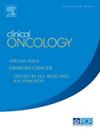Switching to a Fixed-dose Combined Pertuzumab and Trastuzumab With Recombinant Human Hyaluronidase Subcutaneous Injection to Treat Human Epidermal Growth Factor Receptor 2-positive Breast Cancer in Real-world UK Clinical Practice
IF 3.2
3区 医学
Q2 ONCOLOGY
引用次数: 0
Abstract
Current standard of care for human epidermal growth factor receptor 2 (HER2)–positive breast cancer is first-line treatment with chemotherapy in combination with the HER2-targeting monoclonal antibodies, trastuzumab and pertuzumab. While this treatment approach is associated with improved clinical outcomes, there is a treatment burden associated with the invasive and time-consuming nature of separate intravenous (IV) administration of pertuzumab and trastuzumab. In 2020, a novel subcutaneous (SC) formulation of pertuzumab plus trastuzumab with recombinant human hyaluronidase, available as a fixed-dose combination vial that can be administered in 5–8 minutes, was approved for use by the US Food and Drug Administration and the European Medicines Agency.
Aim
A UK cancer centre set out to switch all patients currently receiving IV infusion of pertuzumab and trastuzumab over to the combined SC injection in a safe and timely manner and to initiate all future patients on the combined SC injection.
Materials and methods
Organisational governance approval was obtained before a novel project model approach was used to implement the treatment switch which incorporated aspects such as education and multidisciplinary team collaboration.
Results
Of the 97 eligible patients, 99% were switched to the combined SC injection safely and effectively over a 4-week period. Between 1st April 2021 and 30th September 2022, 3062 hours of pharmacy aseptic preparation time and 6764 hours of day unit chair time were saved. The number of aseptic unit operation days above the maximum capacity was reduced post-switch.
Conclusion
This initiative demonstrated the ability to rapidly and effectively transition >95% of eligible breast cancer patients from separate IV trastuzumab and pertuzumab to a fixed combined SC formulation. Patient benefits included shorter administration appointments and a less invasive form of treatment, whereas healthcare system benefits included substantial savings in aseptic preparation time and chair time, and a meaningful increase in clinic capacity. The reported treatment-switch process provides a model that can be adopted by other centres wishing to implement similar treatment switches.
在英国真实世界的临床实践中,改用固定剂量联合帕妥珠单抗和曲妥珠单抗与重组人透明质酸酶皮下注射治疗人表皮生长因子受体 2 阳性乳腺癌。
目前,人类表皮生长因子受体 2(HER2)阳性乳腺癌的一线治疗标准是化疗联合 HER2 靶向单克隆抗体曲妥珠单抗和 pertuzumab。虽然这种治疗方法可改善临床疗效,但由于pertuzumab 和曲妥珠单抗需要分别进行静脉注射(IV),具有侵入性且耗时较长,因此给治疗带来了负担。2020年,美国食品药品管理局和欧洲药品管理局批准使用一种新型皮下注射(SC)制剂,即含有重组人透明质酸酶的pertuzumab加曲妥珠单抗,该制剂为固定剂量复合瓶,可在5-8分钟内给药。目的:英国一家癌症中心计划在安全、及时的情况下,将目前接受静脉输注培妥珠单抗和曲妥珠单抗的所有患者转为使用联合皮下注射剂,并让今后的所有患者开始使用联合皮下注射剂:结果:在97名符合条件的患者中,99%的患者接受了百妥珠单抗和曲妥珠单抗联合SC注射液治疗:结果:在 97 名符合条件的患者中,99% 的患者在 4 周内安全有效地改用了联合 SC 注射。从 2021 年 4 月 1 日到 2022 年 9 月 30 日,共节省了 3062 个小时的药房无菌准备时间和 6764 个小时的日间手术椅时间。转换后,无菌操作室超过最大容量的操作天数也有所减少:这一举措证明了能够快速有效地将 95% 以上符合条件的乳腺癌患者从单独静脉注射曲妥珠单抗和百妥珠单抗过渡到固定的联合 SC 制剂。患者的获益包括缩短了用药预约时间和采用了创伤较小的治疗方式,而医疗系统的获益则包括大大节省了无菌准备时间和诊疗椅时间,并显著提高了诊疗能力。所报告的治疗转换过程为其他希望实施类似治疗转换的中心提供了可借鉴的模式。
本文章由计算机程序翻译,如有差异,请以英文原文为准。
求助全文
约1分钟内获得全文
求助全文
来源期刊

Clinical oncology
医学-肿瘤学
CiteScore
5.20
自引率
8.80%
发文量
332
审稿时长
40 days
期刊介绍:
Clinical Oncology is an International cancer journal covering all aspects of the clinical management of cancer patients, reflecting a multidisciplinary approach to therapy. Papers, editorials and reviews are published on all types of malignant disease embracing, pathology, diagnosis and treatment, including radiotherapy, chemotherapy, surgery, combined modality treatment and palliative care. Research and review papers covering epidemiology, radiobiology, radiation physics, tumour biology, and immunology are also published, together with letters to the editor, case reports and book reviews.
 求助内容:
求助内容: 应助结果提醒方式:
应助结果提醒方式:


